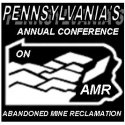Air, Land, Water Highlighted on Tour provided in NEPA while Congress Considers the Future of Funds that support Reclamation of Abandoned Mine Lands
First and foremost, EPCAMR wants to acknowledge all of the coalition partners, reclamation-related industries, Conservation Districts, Trout Unlimited Chapters, watershed associations, and coalfield community groups that have been stepping up and standing up for their communities these last few months on the importance of the Reauthorization of the Surface Mining Control and Reclamation Act (SMCRA). The need is justified and the funding allocations are necessary to continue to reclaim our abandoned mine lands and to treat the AMD water pollution sources to help restore our watersheds. We are sure that most of you are aware that a small fee is collected from the coal industries that remain on every ton of coal mined, both surface and underground, that gets set aside into the Federal Abandoned Mine Land Trust Fund. Those funds are vital to the remaining States like PA, and many others throughout Appalachia for reclamation and remediation of our past mining abandoned mine lands and polluted waterways. Those funds get distributed to the abandoned mine land (AML) States in the form of yearly grants to help reclaim AML and treat polluted abandoned mine drainage (AMD) to help restore our watersheds.
Today’s tour with James Bruggers, a reporter from the Southeast, National Environment Reporting Network, from Louisville, KY, covering a story for Inside Climate News, was hosted by the PA Department of Environmental Protection’s Bureau of Abandoned Mine Reclamation (PA DEP BAMR). EPCAMR attended as well to provide valuable local insight into several of the sites with expertise and commentary provided by Bobby Hughes, EPCAMR Executive Director since two of the three sites are abandoned mine land areas and an AMD site that we have been heavily involved with, along with many other local community partners. These types of projects could not happen without the support of the State and Federal Agencies such as the PA DEP BAMR and the Office of Surface Mining Reclamation and Enforcement (OSMRE) and the funding that is provided to reclaim these areas. Private landowner’s permission and approval are also integral to the success of each and every project. James’ full story will appear in a few weeks.
EPCAMR wanted to provide our view of the importance of today’s tour with him that we hope will get us some National media attention on the importance of Reauthorization sooner, rather than later, as the Infrastructure Bill ((HR 3684) is where a lot of the details are located related to SMCRA Reauthorization and funding for abandoned mine land reclamation and AMD remediation. Hopefully, his story will highlight the jobs that can be created in the Appalachian Coalfields for reclamation, the continued removal of the waste culm piles by our partnering Co-Generation Plants, like Panther Creek Partners, who are a part of the ARIPPA Trade Association and have been a partner of EPCAMR’s since the mid-90s.
The EPCAMR Executive Director discussed the possibilities of future AMD Treatment Plants around the Commonwealth that could create long-term jobs and investments in the coalfield communities that are still living with these large volume, acid-laden, mine waters that should be seen as public infrastructure projects with the added benefit of providing clean water and other recreational and industrial use-value to those who live along them and would ultimately benefit from the restoration of those impaired waters. EPCAMR and PA DEP BAMR both reference the SRBC’s Anthracite Region Mine Drainage Remediation Strategy on the Tour that discusses the potential for combining certain discharges to treat them more effectively.
The 3 Sites visited were:
- Swoyersville Abandoned Mine Land Economic Revitalization (AMLER) Coal Refuse Reclamation and Community Athletic Area Project in Swoyersville Borough, Luzerne County
- Old Forge AMD Borehole discharge in the Lower Lackawanna River Watershed, just above the Connell Street Bridge in Old Forge Borough, Lackawanna County
- Sterry Creek South-Dolph Mine Fire Abandoned Mine Reclamation Project, Olyphant Borough, Lackawanna County

Photo 1. Equipment hauling and removing waste culm, fines, and silts that are several feet in depth from the former Harry E. Colliery abandoned mine land site at the beginning of the project near the Church Street tree line where Roosevelt Park is located just across the street from the Phase I Reclamation for the Community Athletic Area for Swoyersville Borough.

Photo 2. The former Harry E. Colliery Culm banks tower over the community of Swoyersville Borough where the residential homes surround the 55 acre abandoned mine lands in the Abraham Creek watershed on 3 sides. This 45 acre area is denoted as a Phase II site for future reclamation purposes and is not a part of the Phase I reclamation, due to the extensive reclamation costs needed and sheer amount of material that needs to be hauled, graded, and leveled for erosion and sedimentation control.

Photo 3. The Old Forge AMD Borehole as it discharges from the early 1960s concrete culvert diversion chamber that is several hundred feet downstream from the actual 42″ diameter borehole that is located along the Lackawanna River. Iron hydroxide staining is evident during typical lower flow conditions on the riverbed for the lower 3 miles of the Lackawanna River until it’s confluence with the North Branch Susquehanna River. The Connell Street Bridge in Old Forge can be seen from above.

Photo 4. Looking downstream on the Lackawanna River where the iron hydroxide staining is quite evident along the entire length of the river’s right bank. As the increased flows in the river drop from the recent storm events and remnants of Hurricane Ida and others, the muddied waters will turn back to orange and can be seen from Google Earth for the entire length of the lower 3 miles.

Photo 5. From left to right: Todd Wood-PA DEP BAMR NE Office, Bobby Hughes-EPCAMR Executive Director, Brian Bradley-PA DEP BAMR Harrisburg Office, and James Bruggers-Reporter for Inside Climate News, view the downstream impacts on the Lower Lackawanna River as Bobby discusses the impacts from past mining to the St. John’s Creek tributary that losing much of its water to the underground mine pool in the Scranton-Metro Mine Pool Complex.

Photo 6. A panoramic shot looking south taken by the EPCAMR Executive Director, Bobby Hughes, of the cutoff trench that was excavated to the base of the Dunmore No. 3 seam to isolate the mine fire and act as a barrier along the south, west, and north perimeters of the active fire zone and opposite high wall where the Dunmore No. 3 and Dunmore No. 2 (30-40′ below the No. 3) Anthracite veins were mined extensively.

Photo 7. Looking south across the cutoff trench that was excavated at the Dunmore No. 2 Anthracite vein in an anticline formation within the rock with the overburden seen from above in the tree line. You can notice the active venting of the mine gases in the left center of the photo seen as on this rainy day as smoke rising 10-14′ above the active fire zone.

Photo 8. James Bruggers, Reporter, Inside Climate News, captures some iPhone video footage of the venting gases coming from one of the many temperature monitoring boreholes within the active fire zone that is currently being reclaimed and extinguished.

Photo 9. Looking southwest along the isolation trench and vertical high wall opposite the trench where a few of the coal veins can be seen (Dunmore No. 2 and No. 3) and a little split or rider was noticed closer to the surface. Throop is down over the Valley horizon as well as the US Route 6 Highway.

Photo 10. Pinkish red ash from rock, waste culm, and coal that had previously been burned in the fire was excavated and placed along the cuts to create the roads to get around the mine fire site. It looks similar to what you would find in the ash content that you would find in your home if Anthracite coal had been used as a home heating fuel source for a furnace.

Photo 12. Looking down into the abyss and darkness of one of the temperature monitoring boreholes within the active fire zone.

Photo 13. Retired Mining Engineer, John Mack, formerly with the Office of Surface Mining Reclamation and Enforcement Office that used to be located in Wilkes-Barre, PA gives James Brugger, Reporter, Inside Climate News, a historical overview of the project’s beginnings and initial funding sources, as well as the importance of the project due to the proximity of the Jefferson Township Sewer Authority’s infrastructure lines. Larry Dobash (white hat), Brian Bradley, and Tom Ludka-all from PA DEP Bureau of Abandoned Mine Reclamation (PA DEP BAMR), and Bobby Hughes-(orange jacket) listen in on the conversation.

Photo 14. The temperature monitoring borehole capped at the surface within the Dolph Mine Fire zone.
Now that we’ve been able to provide you somewhat of a virtual tour for the day and some of the sites in Northeastern PA’s Anthracite Coal Region, there is a much greater sense of urgency in our work. The fee collection authority for the Surface Mining and Reclamation Act (SMCRA) expires IN 2 DAYS (September 30th, 2021). While there is language to renew the fee collection for several more years in the Infrastructure Bill that was passed by the Senate and is being considered by the House, all of us in the reclamation community are unsure as to whether the House of Representatives will pass that Bill.
If the Infrastructure Bill, which contains the SMCRA Reauthorization language, does not pass, then Congress has two options. The first option is to let SMCRA fee collection sunset, or expire, which will put many State AML Programs and future reclamation and AMD remediation projects and treatment systems in serious jeopardy. The second option is to provide a short-term extension to SMCRA fee collection until such time that Congress can agree on the details surrounding the Reauthorization.
Should it come to an extension, we hope that the House members will vote for that. Individuals who live in our coalfield communities that want to continue to see our land and waterways improved need to continue to have ongoing communications with their respective US State Representatives and Senators regarding the importance of the SMCRA Reauthorization. NOW, more than ever, as the days close in on the sunset date for the fee collection, communications with your local political leaders in the legislature will take on an even more important role.
Please contact your US Representatives, Senator Toomey, and Senator Casey, if you are a PA resident, and let them know of the importance of Reauthorization and Abandoned Mine Reclamation in Pennsylvania and that if it should come to the question of an extension, we hope the House of Representatives will vote for that.
For more information and videos related to the Abandoned Mine Land Trust Fund and Reauthorization, see the PA AML Campaign page, WPCAMR’s and EPCAMR’s YouTube video channels that are relatively new, where some videos can be found of interviews that we’ve had around the State with our partners to emphasize the importance of the work that we do and that all of our partners are doing to reclaim our abandoned mine lands and to clean up and restore our polluted waterways by creating jobs and economic development opportunities on these formerly abandoned mine lands once they are reclaimed and alternative energy uses continue to be developed for both the land, underground mine pool water, and the AMD.
If you are interested in learning more, join us for our 2021 PA Abandoned Mine Reclamation Virtual Conference that will be from October 27-29th.













You must be logged in to post a comment.